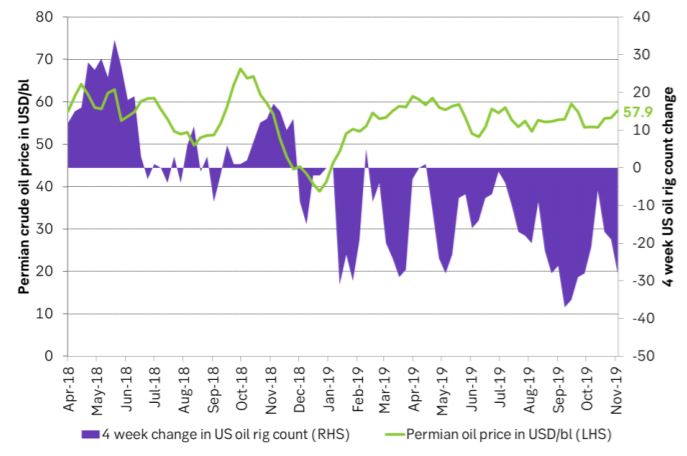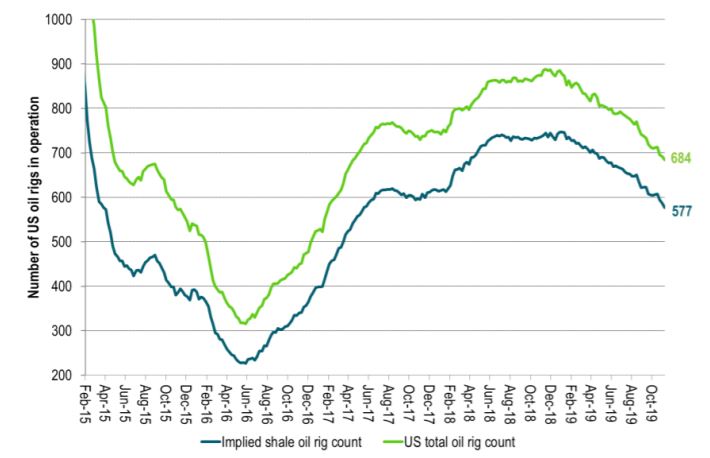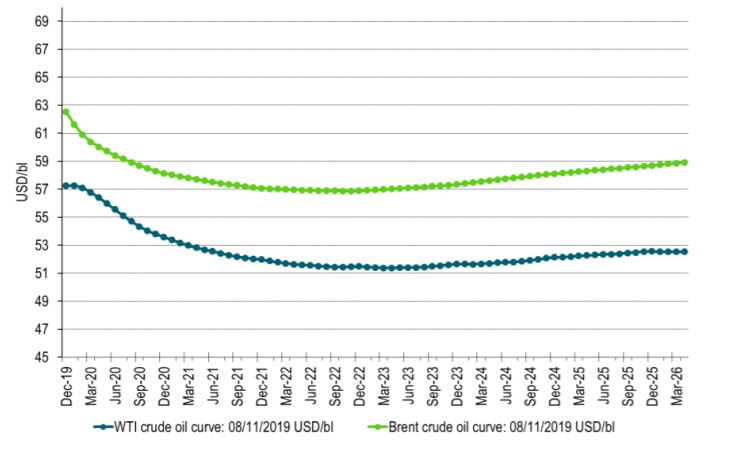Analys
Shale oil reaction function is changing and OPEC is happy


Brent crude had a strong week last week with four out of five closes at the highest level since late September. Recession fears eased (US 10yr moved from 1.71% to 1.94%) and optimism for a US-China trade deal improved. A 1.1% gain in the USD index was not able to hold Brent crude back from gaining 1.3% over the week with a close of $62.51/bl. Brent crude oil is selling off 1% this morning trading at $61.9/bl weighted down by the equity sell-off in Hong Kong / China

OPEC+ has signalled that its members are not overly eager to make deeper cuts at their upcoming meeting (5 December). This has given the oil price some temporary set-backs but it was not at all enough to hold back the oil price last week.
OPEC must be thrilled to see that US shale oil production is slowing and slowing and it is all happening at a Brent crude oil price of about $60-65/bl (WTI $57/bl ytd av). The fear has of course been that you would need to push the WTI price down below $45/bl in order to slow down US shale oil production growth. That was the last price inflection point back in May 2016 at which US shale oil activity accelerated again following the 2014/15 sell-off. The “shale oil reaction function” (activity as a function of the oil price) has clearly changed.
This change has not at all been incorporated into spot and forward prices yet. The longer dated WTI prices are typically between $50-53/bl from 2021 and all out to 2030. These prices are nominal. If we look at the forward WTI price for 2030 it is currently $52.3/bl in nominal terms. If we adjust for the US 10yr inflation swap of 1.92% this converts to a real forward price of $43.1/bl.
There is no doubt that the US has plenty of shale oil resources left. It is also clear that the US shale oil players have the technology to extract at a strong growth pace. This is also what OPEC has reflected in its latest World Oil Outlook where it projects US shale oil production to grow by another 5.3 m bl/d from 2019 to 2030.
The big question is of course at what price will this happen? Will it happen at a real forward WTI price of $45-50/bl? The current US shale oil slow-down basically says no. Market action so far this year is instead saying that at WTI $55/bl activity and production is slowing rapidly.
We have asked US shale oil players what they would do if the WTI price moved to $65-70/bl in 2020. The response was quite clear: Pay down debt, pay dividends and engage in share buy-backs if possible. So no expansion again even with a WTI price moving to $65-70/bl. This is in stark contrast to forward WTI prices currently saying that US shale oil will deliver strong volume growth at a real forward price of $45-50/bl. Yes, the US has lots of shale oil resources and it can deliver lots of growth but at what price? That’s the question. The current market assumption that this will happen year after year at a real oil price of $45-50/bl is in our view wrong. That is also what this year’s shale oil activity is showing.
Getting back again to Occidental Petroleum, the biggest US shale oil player in the Permian basin, and its recent announcement that it will slash capex spending in shale oil by 50% in 2020. What does this mean? The shale oil well completion rate in the US is now typically running at around 1400 wells/month. If this completion rate declines by only 10% then US shale oil production will experience zero growth.
US shale oil players have been kicking out drilling rigs all of 2019. Last week 7 more oil rigs were kicked out. That’s a monthly decline rate of about 30 drilling rigs per month. The average decline rate so far this year is about 20 rigs per month. I.e. the rig decline is speeding up and the latest message from Occidental says that this is not at all the end of it with more rig declines to come.
So OPEC should be highly content. The market is punishing US shale oil players at WTI $55/bl and Brent at $60/bl. Puh, what a relief. You don’t need to go all the way down to $45/bl and below before US shale oil production growth tapers.
OPEC is totally happy with an oil price (Brent) of $60-65/bl and especially so because they see that at this price US shale oil activity is actually cooling down. We should see a very confident OPEC when they meet in December.
At some point in time here there is likely going to be a repricing of the longer dated WTI prices as the understanding sinks in that US shale oil production is not going to provide booming production growth for another 10 years at a real WTI price of $45-50/bl.
Ch1: Local US Permian crude oil price in USD/bl vs the 4 week change in US oil drilling rig count.

Ch2: US drilling rig count falling and falling

Ch3: Brent and WTI forward price curves. The Brent crude oil curve is in backwardation as a reflection of current crude oil tightness. Still midterm depression on concerns for 2020

Analys
Tightening fundamentals – bullish inventories from DOE

The latest weekly report from the US DOE showed a substantial drawdown across key petroleum categories, adding more upside potential to the fundamental picture.

Commercial crude inventories (excl. SPR) fell by 5.8 million barrels, bringing total inventories down to 415.1 million barrels. Now sitting 11% below the five-year seasonal norm and placed in the lowest 2015-2022 range (see picture below).
Product inventories also tightened further last week. Gasoline inventories declined by 2.1 million barrels, with reductions seen in both finished gasoline and blending components. Current gasoline levels are about 3% below the five-year average for this time of year.
Among products, the most notable move came in diesel, where inventories dropped by almost 4.1 million barrels, deepening the deficit to around 20% below seasonal norms – continuing to underscore the persistent supply tightness in diesel markets.
The only area of inventory growth was in propane/propylene, which posted a significant 5.1-million-barrel build and now stands 9% above the five-year average.
Total commercial petroleum inventories (crude plus refined products) declined by 4.2 million barrels on the week, reinforcing the overall tightening of US crude and products.


Analys
Bombs to ”ceasefire” in hours – Brent below $70

A classic case of “buy the rumor, sell the news” played out in oil markets, as Brent crude has dropped sharply – down nearly USD 10 per barrel since yesterday evening – following Iran’s retaliatory strike on a U.S. air base in Qatar. The immediate reaction was: “That was it?” The strike followed a carefully calibrated, non-escalatory playbook, avoiding direct threats to energy infrastructure or disruption of shipping through the Strait of Hormuz – thus calming worst-case fears.

After Monday morning’s sharp spike to USD 81.4 per barrel, triggered by the U.S. bombing of Iranian nuclear facilities, oil prices drifted sideways in anticipation of a potential Iranian response. That response came with advance warning and caused limited physical damage. Early this morning, both the U.S. President and Iranian state media announced a ceasefire, effectively placing a lid on the immediate conflict risk – at least for now.
As a result, Brent crude has now fallen by a total of USD 12 from Monday’s peak, currently trading around USD 69 per barrel.
Looking beyond geopolitics, the market will now shift its focus to the upcoming OPEC+ meeting in early July. Saudi Arabia’s decision to increase output earlier this year – despite falling prices – has drawn renewed attention considering recent developments. Some suggest this was a response to U.S. pressure to offset potential Iranian supply losses.
However, consensus is that the move was driven more by internal OPEC+ dynamics. After years of curbing production to support prices, Riyadh had grown frustrated with quota-busting by several members (notably Kazakhstan). With Saudi Arabia cutting up to 2 million barrels per day – roughly 2% of global supply – returns were diminishing, and the risk of losing market share was rising. The production increase is widely seen as an effort to reassert leadership and restore discipline within the group.
That said, the FT recently stated that, the Saudis remain wary of past missteps. In 2018, Riyadh ramped up output at Trump’s request ahead of Iran sanctions, only to see prices collapse when the U.S. granted broad waivers – triggering oversupply. Officials have reportedly made it clear they don’t intend to repeat that mistake.
The recent visit by President Trump to Saudi Arabia, which included agreements on AI, defense, and nuclear cooperation, suggests a broader strategic alignment. This has fueled speculation about a quiet “pump-for-politics” deal behind recent production moves.
Looking ahead, oil prices have now retraced the entire rally sparked by the June 13 Israel–Iran escalation. This retreat provides more political and policy space for both the U.S. and Saudi Arabia. Specifically, it makes it easier for Riyadh to scale back its three recent production hikes of 411,000 barrels each, potentially returning to more moderate increases of 137,000 barrels for August and September.
In short: with no major loss of Iranian supply to the market, OPEC+ – led by Saudi Arabia – no longer needs to compensate for a disruption that hasn’t materialized, especially not to please the U.S. at the cost of its own market strategy. As the Saudis themselves have signaled, they are unlikely to repeat previous mistakes.
Conclusion: With Brent now in the high USD 60s, buying oil looks fundamentally justified. The geopolitical premium has deflated, but tensions between Israel and Iran remain unresolved – and the risk of missteps and renewed escalation still lingers. In fact, even this morning, reports have emerged of renewed missile fire despite the declared “truce.” The path forward may be calmer – but it is far from stable.
Analys
A muted price reaction. Market looks relaxed, but it is still on edge waiting for what Iran will do

Brent crossed the 80-line this morning but quickly fell back assigning limited probability for Iran choosing to close the Strait of Hormuz. Brent traded in a range of USD 70.56 – 79.04/b last week as the market fluctuated between ”Iran wants a deal” and ”US is about to attack Iran”. At the end of the week though, Donald Trump managed to convince markets (and probably also Iran) that he would make a decision within two weeks. I.e. no imminent attack. Previously when when he has talked about ”making a decision within two weeks” he has often ended up doing nothing in the end. The oil market relaxed as a result and the week ended at USD 77.01/b which is just USD 6/b above the year to date average of USD 71/b.

Brent jumped to USD 81.4/b this morning, the highest since mid-January, but then quickly fell back to a current price of USD 78.2/b which is only up 1.5% versus the close on Friday. As such the market is pricing a fairly low probability that Iran will actually close the Strait of Hormuz. Probably because it will hurt Iranian oil exports as well as the global oil market.
It was however all smoke and mirrors. Deception. The US attacked Iran on Saturday. The attack involved 125 warplanes, submarines and surface warships and 14 bunker buster bombs were dropped on Iranian nuclear sites including Fordow, Natanz and Isfahan. In response the Iranian Parliament voted in support of closing the Strait of Hormuz where some 17 mb of crude and products is transported to the global market every day plus significant volumes of LNG. This is however merely an advise to the Supreme leader Ayatollah Ali Khamenei and the Supreme National Security Council which sits with the final and actual decision.
No supply of oil is lost yet. It is about the risk of Iran closing the Strait of Hormuz or not. So far not a single drop of oil supply has been lost to the global market. The price at the moment is all about the assessed risk of loss of supply. Will Iran choose to choke of the Strait of Hormuz or not? That is the big question. It would be painful for US consumers, for Donald Trump’s voter base, for the global economy but also for Iran and its population which relies on oil exports and income from selling oil out of that Strait as well. As such it is not a no-brainer choice for Iran to close the Strait for oil exports. And looking at the il price this morning it is clear that the oil market doesn’t assign a very high probability of it happening. It is however probably well within the capability of Iran to close the Strait off with rockets, mines, air-drones and possibly sea-drones. Just look at how Ukraine has been able to control and damage the Russian Black Sea fleet.
What to do about the highly enriched uranium which has gone missing? While the US and Israel can celebrate their destruction of Iranian nuclear facilities they are also scratching their heads over what to do with the lost Iranian nuclear material. Iran had 408 kg of highly enriched uranium (IAEA). Almost weapons grade. Enough for some 10 nuclear warheads. It seems to have been transported out of Fordow before the attack this weekend.
The market is still on edge. USD 80-something/b seems sensible while we wait. The oil market reaction to this weekend’s events is very muted so far. The market is still on edge awaiting what Iran will do. Because Iran will do something. But what and when? An oil price of 80-something seems like a sensible level until something do happen.
-

 Nyheter3 veckor sedan
Nyheter3 veckor sedanStor uppsida i Lappland Guldprospekterings aktie enligt analys
-

 Nyheter4 veckor sedan
Nyheter4 veckor sedanBrookfield ska bygga ett AI-datacenter på hela 750 MW i Strängnäs
-

 Nyheter3 veckor sedan
Nyheter3 veckor sedanSilverpriset släpar efter guldets utveckling, har mer uppsida
-

 Nyheter3 veckor sedan
Nyheter3 veckor sedanUppgången i oljepriset planade ut under helgen
-

 Nyheter3 veckor sedan
Nyheter3 veckor sedanLåga elpriser i sommar – men mellersta Sverige får en ökning
-

 Analys3 veckor sedan
Analys3 veckor sedanVery relaxed at USD 75/b. Risk barometer will likely fluctuate to higher levels with Brent into the 80ies or higher coming 2-3 weeks
-

 Nyheter2 veckor sedan
Nyheter2 veckor sedanMahvie Minerals växlar spår – satsar fullt ut på guld
-

 Nyheter1 vecka sedan
Nyheter1 vecka sedanOljan, guldet och marknadens oroande tystnad







